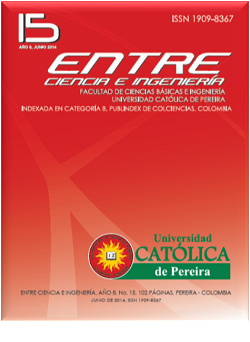Evaluation of classroom interventions results through multivariate techniques when teaching statistics
Keywords:
statistical analysis, analysis of variance, educational technologyAbstract
Statistics is a subject that presents difficultieswhen taking it to a level of practical understanding. It isused in modeling random phenomena and is indispensable ininvestigations involving uncertainty. The statistic that guidesthe Department of Physics and Mathematics (Universidadde Manizales -UAM) seeks the improvement in engineeringstudents, of stochastic thinking and understanding ofprobabilistic laws incorporating information technologies.A research instrument of previous ideas (IIP) was adopted fortwo purposes, first of all visualize stochastic preconceptionsand then, develop teaching units (DU) for teaching statistics.The three groups of IIP statistics was applied at the beginningand end of the semester II 2011 doing classroom interventiondesigned by UD. To compare results obtained, IIP was used inthree courses of I-2012 without using UD. With these resultscompare multinomial proportions, MANOVA and associationtests were performed in order to analyze the impact of theintervention.
References
C. Batanero, “Training Researchers in the Use of Statistics,” International Association for Statistical Education and International Statistical Institute, pp. 385-396, 2001.
Cox D.R, “The current position of statistics: A personal view.,” International Statistical., pp. 261-276, 1997. [3] J. Gómez Arias, “Una actividad para la enseñanza de la probabilidad diseñada con el método histórico cultura de Vigostky y la teoría de la actividad de Leóntiev,” Acta latinoamericana de Matemática Educativa, pp. 416- 426, 2008.
A. R. Gil Armas, “La estadística oficial en el aula,” Revista Iberoamericana de educación Matemática, nº 24, pp. 177-182, 2010.
H. M. Trevethan, V. YumiKataoka y M. S. Oliveira, “El uso de juegos para la promoción del razonamiento probabilístico.,” Revista Iberoamericana de Educación matemática, vol. 69, 2010.
L. A. Toro, “Modelo computacional Representacional de la Matemática,” Revista Anfora, vol. 28, pp. 151-178, 2010.
L. G. Díaz Monroy y M. A. Morales Rivera, “Análisis estadístico de datos multivariados,” Bogotá: Universidad Nacional de Colombia, 2012. [8] K. Pillai, “Some new test criteria in Multivariate Analysis,” Annals of Mathematical Statistics, vol. 26, pp. 117-121, 1955.
H. Hotelling, “The Generalization of Student’s ratio,” Annals of Mathematical Statistics, vol. 2, pp. 360-378, 1931.
S. Roy, “On a heuristic method of test construction and its use in multivariate analysis,” Annals of Mathematical Statistics, vol. 24, pp. 220- 230, 1953.
J. Clavijo M, “Apuntes de Análisis Multivariado,” Ibagué Colombia: Universidad del Tolima, 2005.
M. Barlett, “Anote on multiplying factors for various chi-square approximations,” Journal of the Royal Satistical Society, Series B, vol. 16, pp. 296-298, 1954.
C. D. y. H. Quesenberry, “Large Simple Simulataneous Confidence Intervals for Multinomial Proportions,” Technometrics, vol. 6, pp. 191-195, 1964.
C. Sáenz Castro, “Intuición y matemática en el razonamiento y aprendizaje probabilístico.,” Universidad Autónoma de Madrid, Facultad de Psicología, Departamento, Madrid España, 1995.








 Revista Entre Ciencia e Ingeniería
Revista Entre Ciencia e Ingeniería .png) entrecei@ucp.edu.co
entrecei@ucp.edu.co.png) ISSN (Impreso) 1909-8367 - ISSN (En Línea) 2539-4169
ISSN (Impreso) 1909-8367 - ISSN (En Línea) 2539-4169 Attribution-NonCommercial 4.0 International (CC By-NC 4.0)
Attribution-NonCommercial 4.0 International (CC By-NC 4.0)
.png) Carrera 21 No. 49-95 Av. de las Américas, Pereira, Risaralda, Colombia
Carrera 21 No. 49-95 Av. de las Américas, Pereira, Risaralda, Colombia